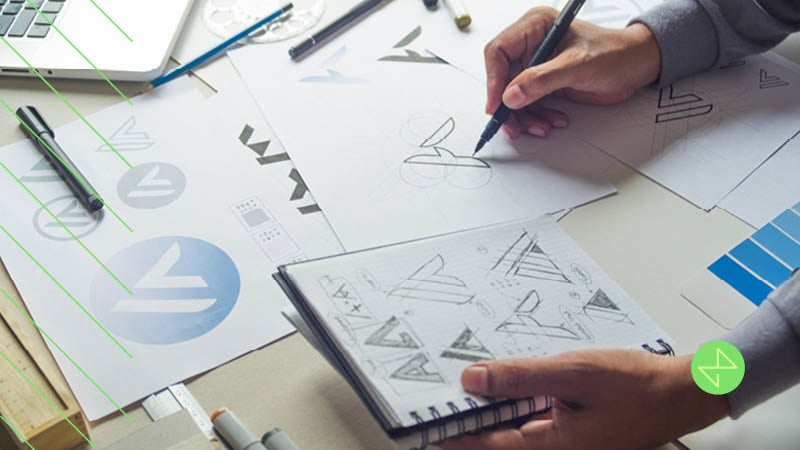
How to Build an Effective Visual Identity
To tell your company’s story to consumers, you’ll need a strong visual identity. This guide teaches the basics, from logos to fonts to color palettes.
Today, brand identities are more important than ever before. According to Forbes, the average American sees at least 4,000 advertisements each day. Surrounded by so many brands, consumers have little time to judge products and services. Therefore, they rely heavily on shortcuts like product names and logos. This is why an effective brand identity can make the difference between a succeeding and failing business.
What Factors Go Into a Brand Identity?
- What products or services does your company offer?
- What differentiates your company from your competitors?
- What is your company’s history?
- Who is your target audience?
- Where will your brand be seen?
- What values does your company stand for?
| Your visual identity will be the first component of your brand that consumers notice. Visual information is processed by the brain 60,000x faster than text. |
What is a Visual Identity?
A full brand identity might include verbal, visual, sonic, and even haptic identities. However, the rest of this blog will focus specifically on visual identities. A visual identity is a set of design elements that makes up the appearance of a brand, and ensures consistency across communications. At minimum, it includes a company logo, typeface, and color palette. But a more elaborate visual identity might include iconography, photography, illustration, motion design, data visualization, and more. A visual identity should also include guidelines for how each of these elements is used, to ensure consistency across branded materials.
With the above overview in mind, we can hone in on some specifics: logos, typefaces, and color palettes. But first, a quick disclaimer: branding is a creative discipline, and there is no one-size-fits-all visual identity (if there were, my job as a graphic designer would be a lot easier and a lot less fun). Although there is no best typeface, best color, or best style, there are certain commonalities between successful visual identities. Here are a few of them:
Logos
Logos are meant to convey a lot of information in a short amount of time. In that sense, a logo can be thought of as the visual equivalent to a slogan—it is one concise visual message that captures a company’s essence. It should hint at the company’s product, differentiators, or mission, while staying completely streamlined. In fact, it should be so streamlined that anyone who has viewed the logo a few times should be able to draw it. The most iconic logos, like Nike, Apple, and the Olympics are easily recalled because of their simplicity.
As the center of your brand, your logo will be used across a wide variety of applications—from desktop to mobile to OTT to magazines—so make it versatile. Design alternative logos in black, white, and full color. Make sure that your logo is legible even when shrunk down to small sizes. Consider making versions of your logo with a shortened wordmark, or no wordmark at all. To illustrate logo versatility, see all the different versions of Amazon’s logo, depending on context.
 Turer Duckworth
Turer Duckworth
Typography
Your brand’s typography should reinforce your overall messaging. Whether your brand’s tone of voice is playful, serious, modern, or traditional, fitting typefaces (typeface basically means font) will amplify that tone. Plus, your chosen typefaces must complement your logo, and live well in the same space. Uber’s proprietary typeface Uber Move is an example of a successful type choice. Not only does the geometric sans serif evoke the tech industry, but its emphasis on right angles takes inspiration from street intersections and directional signage.
 MCKL Type Foundry
MCKL Type Foundry
When choosing typefaces, keep functionality in mind. To achieve visual hierarchy in your designs, choose flexible typefaces, with many font weight options. Limit yourself to 1-3 typefaces, and assign each font to its own role, like headers, body copy, or callouts. Keep in mind that different typefaces lend themselves to different roles. Stylized display typefaces work well for logos, but badly for body copy, due to their lack of legibility. A good rule of thumb is: that the more copy there is, the more you should prioritize legibility.
Color Palette
Just like your logo and typeface, your color palette should drive home your brand’s message. When building palettes, designers often pull colors from products or symbols that relate to the company. For example, Burger King’s brand colors come from the Whopper.
Keep color psychology in mind while choosing your palette. Here are some common emotions evoked by each color, according to Verywell:

- Red: Anger, love, power
- Orange: Energy, enthusiasm, happiness
- Yellow: Warmth, attention, brightness
- Green: Nature, safety, luck
- Blue: Productivity, calmness, sadness
- Purple: Wealth, mystery, imagination
Make sure that your color palette is versatile enough for your communications. Wix advises brands to choose one primary color, and two–four secondary colors. For legibility, choose colors with a wide range of values, including light, midtone, and dark colors.
So You've Built a Visual Identity. Now What?
Lastly, remember to continually evolve your brand, to reflect changes in your company and the world around it. Rebranding will help you adapt your communications to market disruptions, cultural shifts, and technological advancements. In such a fast-changing landscape, most companies rebrand every 7-10 years.
So there you have it: a 50,000 foot view of visual identities. Even though I could not give you an objective formula for success, I hope that the broad goals and guardrails in this blog can help guide you.
Keep in mind that creating a visual identity is only the first step in your marketing efforts—the next step is getting your brand in front of the right people at the right time. To reach your target audience, you need expert media strategy, buying, planning, and execution. Contact us to ensure that your marketing campaigns thrive.


